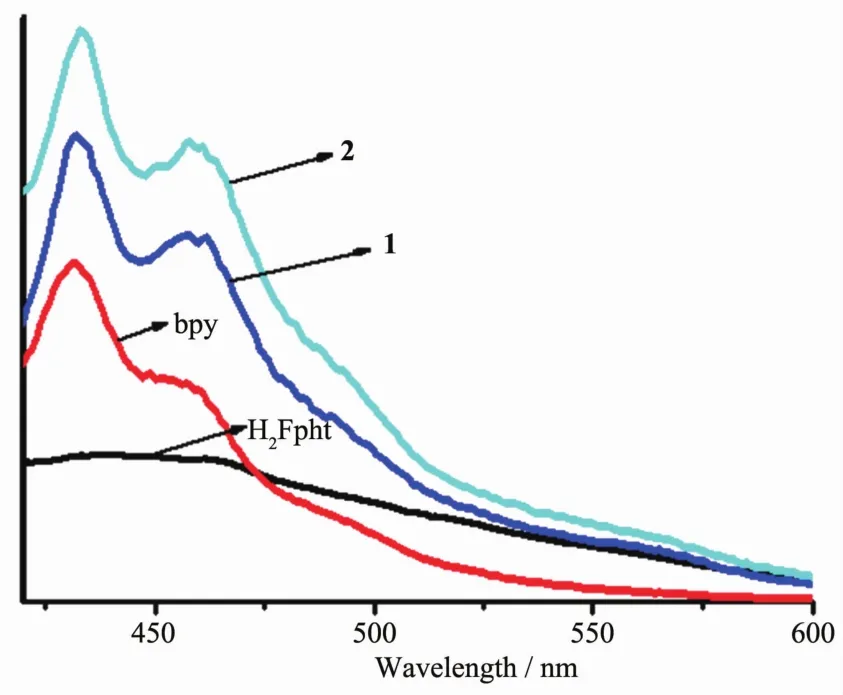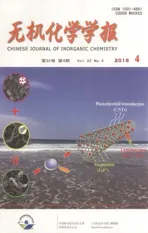温度控制的原位脱羧3-氟邻苯二甲酸与铅配位聚合物的合成、晶体结构及荧光性质
2016-05-03屈相龙
屈相龙 宋 爽 赵 凯 李 夏
(首都师范大学化学系,北京 100048)
屈相龙宋爽赵凯李夏*
(首都师范大学化学系,北京100048)
摘要:Pb(NO3)2与3-氟邻苯二甲酸(H2Fpht)和2,2′-联吡啶(bpy)在不同水热反应温度下获得了2个新的配位聚合物:[Pb(Fba) (bpy)(NO3)]n(1)和[Pb4O2(Fba)4]n(2)。3-氟邻苯二甲酸配体经由原位脱羧生成了3-氟苯甲酸根(Fba)。配合物1具有Pb-NO3-Pb双螺旋链结构,是由硝酸根桥联四方反棱柱[PbO6N2]结构单元而形成,而Fba与bpy配体螯合配位于中心铅离子。配合物2为Pb-OH-Pb链状结构,包含四面体结构单元[Pb4(μ4-OH)4](4+),且具有4个晶体学独立的铅离子中心:Pb(1)O6、Pb(2)O6、Pb(3)O5和Pb(4) O5。这两个配合物链分别经氢键作用力自组装为三维超分子网络结构。室温下,测定了配合物的固体荧光光谱,均显示为基于配体的荧光发射。有意思的是,通过荧光淬灭机理配合物2可以选择性地检测硝基苯。
关键词:铅配合物;3-氟邻苯二甲酸;晶体结构;荧光
*通信联系人。E-mail:xiali@mail.cnu.edu.cn
0 Introduction
Metal-organic frameworks (MOFs) have become one of particularly popular subjects, which is attributed to their intriguing diversity of the structures and potential applications in magnetism, gas adsorption, catalysis, luminescence and so on[1-6]. The differences of MOFs lie in different properties of metal ions and diverse chemical structure of the ligands. Furthermore, the MOFs self-assembly process can be influenced by solvent system, pH value, reaction temperature and concentration. A variety of MOFs have been constructed by careful selection of the metal ions and multidentate bridging ligands[7-8]. As a heavy p-block metal ion, Pbexhibits unique coordination preferences, such as large ionic radius, flexible coordination environment, variable coordination numbers ranging from 2 to 10[9-17]. This presents unique opportunities for the assembly and synthesis of Pbcomplexes with interesting structures and physicochemical properties, such as luminescence, photovoltaic conversion and fluorescence sensing. Hence, there is a great significance in exploring new Pbcoordination polymers for their novel structures and fluorescence sensing. However, the recognition and sensing of small organic molecules have important roles in biological and environmental systems[3,18-20]. Up to now, the aromatic carboxylates have been widely used to construct MOFs because of their excellent coordinating ability,π-conjugated system and a variety of coordination modes[5,7-8]. However, fluorinated organic ligands may impart a variety of functional properties, such as higher gas affinity and excellent photoluminescence properties[17,21-24]. 3-Fuorophthalic acid (H2Fpht) has an interesting conformation: (1) its two carboxylate groups on the aromatic rings are 1,2-positions; (2) the F atom has the electron-withdrawing nature and the electrostatic repulsion between the F atom and the carboxylate oxygen atom. So, H2Fpht is a good candidate for construction of MOFs with intriguing structural features and properties[17,21-22].
More recently, we have reported two Pbcomplexes, [Pb2(Fpht)2(bpy)(H2O)2]·2H2O and Pb5(Fpht)4(Fba)2, which derived from H2Fpht in the presence and absence of 2,2′-bipyridine (bpy) by hydrothermal reaction at 160℃[17]. They show interesting structures and photoluminescence. Herein, to further investigate the Pbchemistry with H2Fpht ligand, hydrothermal reactions of Pb(NO3)2and H2Fpht in the presence of bpy were studied. Interestingly, two new 1D coordination polymers, [Pb(Fba)(bpy)(NO3)]n(1) and [Pb4O2(Fba)4]n(2) were obtained at 170℃and 180℃, respectively. The 3-fluorobenzoate (Fba) results from the in situ decarboxylation of H2Fpht. Herein we report the synthesis and structural characterization of the two complexes obtained from the in situ reaction under hydrothermal conditions at different temperatures, and their luminescence property will also be described. Notably, the two complexes exhibit similar fluorescence property, and the fluorescence can be quenched greatly by nitrobenzene, demonstrating its sensing capacity.
1 Experimental
1.1 Materials and physical measurement
All reagents were commercially available and used without purification. Elemental analyses (C, H, and N) were performed on an Elementar Vario EL analyzer. Infrared (IR) spectra were measured on a Bruker Tensor 37 spectrophotometer using KBr pellets from 400 to 4 000 cm-1. Fluorescence spectra were recorded on an FL4500 fluorescence spectrophotometer (Japan Hitachi company) at room temperature. Thermogravimetric analyses (TGA) were carried out using a HCT-2 thermal analyzer under air from room temperature to 800℃with a heating rate of 10℃·min-1.
1.2 Syntheses of complexes 1 and 2
Preparation of [Pb(Fba)(bpy)(NO3)]n(1). A mixture of Pb(NO3)2(0.2 mmol), H2Fpht (0.2 mmol), H2O(10 mL), bpy (0.1 mmol) and an aqueous solution of NaOH (2 mol·L-1, 0.15 mL) was sealed in a Teflon-lined reactor and heated at 170℃for 3 days. After slow cooling to room temperature, colorless block crystals of the complex were obtained. Yield: 43% (based on Pb). Elemental analysis Calcd. for C17H12FN3O5Pb (%): C, 36.14; N, 7.44; H, 2.12; Found (%): C, 35.64; N,7.09; H, 2.08. IR(KBr pellet, cm-1): 3 435(s), 1 552 (vs), 1 529(vs), 1 468(m), 1 384(vs), 1 243(w), 1 156 (w), 1 062(w), 1 014(w), 844(s), 765(s), 734(m), 698 (w), 644(w), 573(w), 466 (m).
Preparation of [Pb4O2(Fba)4]n(2). Complex 2 was prepared as described for 1 except that the temperature was 180℃. Colorless block crystals. Yield: 43% (based on Pb). Elemental analysis Calcd. for C28H16F4O10Pb4(%): C, 23.71; H, 1.13; Found (%): C, 23.48; H, 1.07. IR(KBr pellet, cm-1): 3 433(m), 1 543(vs), 1 473(m), 1 387(vs), 1 266(w), 1 155(w), 1 096(w), 1 008(w), 851(s), 766(s), 691(w), 669(w), 575(w), 465 (m), 432(w).
1.3 X-ray crystal structure determination
The X-ray single-crystal data collections for 1 and 2 were performed on a Bruker Smart ApexⅡCCD diffractometer equipped with graphite monochromated Mo Kα radiation (λ=0.071 073 nm) at 293(2) K. Semiempirical absorption correction was applied on the complex using SADABS program[25]. The structure was solved by direct methods and refined by full matrix least squares on F2using SHELXS 97 and SHELXL 97[26-27]. All non-hydrogen atoms in the complexes were refined an isotropically. Hydrogens were generated geometrically and treated by a mixture of independent and constrained refinement. A summary of the crystallographic data and details of the structure refinements are listed in Table 1. Selected bond distances and angles are listed in Table 2.
CCDC: 1055033, 1; 1055034, 2.

Table1 Crystallographic data and structure refinement of complexes 1~2
2 Results and discussion
2.1 Synthesis
The hydrothermal reactions have generated great attention in the past decade because the hydrothermal synthesis can result in the generation of novel coordination compounds, exhibiting structural diversityand unique properties for potential applications. In our previously reported reaction systems containing Pb(NO3)2and H2Fpht in the presence and absence of bpy, we have prepared two complexes, [Pb2(Fpht)2(bpy) (H2O)2]·2H2O and Pb5(Fpht)4(Fba)2, by the hydrothermal reactions at 160℃. In absence of secondary ligand bpy, H2Fpht was partly converted into HFba by the loss of one carboxyl group, and resulted in the formation of Pb5(Fpht)4(Fba)2. In order to further investigate reaction system of Pb(NO3)2-H2Fpht in the presence of bpy, we change the hydrothermal reaction to 170℃and180℃. Interestingly, two new coordination polymers [Pb(Fba)(bpy)(NO3)]n(1) and [Pb4O2(Fba)4]n(2) were obtained. H2Fpht ligand turned into 3-fluorobenzate (Fba) by decarboxylation reaction. The result shows that the Pbcomplexes containing H2Fpht depend on the reaction temperature. The TGA curves are unchanged from room temperature to 182℃for 1 and 164℃for 2, indicating thermal stability. Then, the frameworks begin to decompose until 462℃for 1 and 449℃for 2, corresponding to release of ligands.

Table2 Selected bond distances (nm) and angles (°) of complexes 1 ~2
2.2 Structural description of 1 and 2
Structural description of [Pb(Fba)(bpy)(NO3)]n(1). X-ray crystallographic analysis reveals that complex 1 crystallizes in triclinic space group P1 and has a 1D zigzag chain (Fig.1). The asymmetric unit of 1 contains one Pbion, one bpy ligand, one Fba ligand, and one NO3-group. Central Pbion is eightcoordinated by two nitrogen atoms (N1 and N2) of bpy, two oxygen atoms (O1 and O2) of Fba, and four oxygen atoms (O3A, O3B, O4B and O5) of three nitrate groups and is in a distorted square antiprism geometry (Fig.1a). The bpy molecule chelates Pbion forming a five-membered ring with Pb-N bond lengths of 0.241 9(5) and 0.246 1(5) nm. The Fba ligand adopts μ1∶η1η1bidentate chelating mode and coordinates Pbion, in which the bond distances of Pb-O are 0.263 0(4) and 0.244 8(4) nm. The NO3-adopts μ3∶η1η1η2coordination mode and acts as a tetradentate ligand to link three different Pbions, in which the bond distances of Pb-O are 0.280 7(5), 0.287 8(4), 0.288 2(6) and 0.290 3(5) nm. The bond distances of Pb-O (NO3) are longer than those of Pb-O (Fba). Comparable to the reported literatures, the distances of Pb-N and Pb-O are close to the values in the literature[9]. The bond angle of N-Pb-N is 66.47 (15)°. The bond angles of O-Pb-O are range from 44.67(4)°to 124.35(2)°. The four atoms of the NO3-are almost coplanar with the mean deviations of 0.000 4 nm. The adjacent Pbions are connected by NO3-groups resulting in a 1D zigzag chain structure. The angle of Pb…Pb…Pb is 75.70(4)°and the distances of Pb…Pb are 0.498 3(3) and 0.566 6(2) nm. The bpy and Fba ligands lie at both side of the chain and are almost perpendicular with the dihedral angle of 96.1(3)°, which may decrease steric hindrances of the two chelating ligands around the Pbion. Interestingly, the Pb-NO3-Pb chain forms double helical architecture with the screw of pitch being 0.655 5 nm, which has a repeat unit consisting of two Pbcenters, two NO3groups along a axis (Fig.1b). It is noteworthy that such 1D structure by tetradentate nitrates linking metal centers is rare[10]. The adjacent chains are connected by C -H…F hydrogen bonds (d(C…F)=0.236 3(4) nm) between bpy and Fba ligands to form the 2D network paralleling the ac plane, which is further extended into a 3D supramolecular assembly by C-H…O hydrogen bonds (d (C…O)= 0.268 9(3) nm) between bpy and NO3-ligands (Fig.1c). Interestingly, new helical motifs are observed by using C-H…F and C-H…O hydrogen bonds as linkers, respectively.

Fig.1 View of the structure of 1: (a) Coordination environment of Pbion with 50% thermal ellipsoids;(b) 1D Pb-NO3-Pb zigzag chain; (c) 3D network by C-H…F and C-H…O weak interactions
Structural description of [Pb4O2(Fba)4]n(2). Complex 2 crystallizes in orthorhombic space group Fdd2 and possesses an infinite Pb-OH-Pb chain structure (Fig.2). There are four crystallographically independent Pbions: Pb1O6, Pb2O6, Pb3O5and Pb4O5(Fig. 2a). Pb1 is six-coordinated by four oxygen atoms of Fba ligands and two μ4-O atoms. The bond distances of Pb1-O vary from 0.229 1(5) to 0.296 0(3) nm. Pb2is six-coordinated by four oxygen atoms of Fba ligands and two μ4-O atoms. The bond distances of Pb2-O vary from 0.220 9(2) to 0.284 2(3) nm. Pb3 is fivecoordinated by three oxygen atoms of Fba ligands and two μ4-O atoms. The bond distances of Pb3-O vary from 0.229 6(4) to 0.281 6(4) nm. Pb4 is five-coordinated by three oxygen atoms of Fba ligands and two μ4-O atoms. The bond distances of Pb4-O vary from 0.222 5(3) to 0.291 8(4) nm. Thereinto, the Pb1-O6A, Pb2-O3B, Pb3-O8A and Pb4-O7 bonds are significantly longer and the distances are 0.296 0(3), 0.284 2(3), 0.281 6(4) and 0.291 8(4) nm, respectively. All the distances of Pb-N and Pb-O are close to the values in the literatures[9]. In 2, Fba ligands adopt three different coordination modes,μ2∶η1η1,μ3∶η1η1and μ3∶η2η2to link two or three different Pbions (Scheme 1). Each Pband its three nearest Pbions are connected together by μ4-hydroxyl bridging ligands (O9 or O10), forming a tetrahedron-like cluster [Pb4(μ4-OH)4]4+with the Pb…Pb distances of 0.344 0(3)~ 0.398 5(3) nm, in which four Pbions are located at the corner angles of the neighbouring tetrahedron (Fig. 2b). The tetrahedron [Pb4(μ4-OH)4]4+unit distorts, in which the Pb-O-Pb angles vary from 95.2(8)°to 123.0(1)°. The tetrahedron [Pb4(μ4-OH)4]4+units further extended into a Pb-OH-Pb chain structure, in which the octanuclear Pbclusters act as secondary building blocks (SBUs). The 1D chain motifs are further connected into 3D supramolecular network by C-H…O and C-H…π noncovalent interactions (Fig.2c). The C-H …O hydrogen bond formed between C-H of Fba and carboxylate oxygen atom of Fba with the C…O distance of 0.330 1(3) nm. The C-H…π interaction exists between adjacent Fba ligands with the distance of 0.284 2(4) nm.

Fig.2 View of the structure of 2: (a) Coordination environments of Pbion with 30% thermal ellipsoids; (b) 1D chain structure embracing a tetrahedron-like cluster [Pb4(μ4-OH)4]4+; (c) 3D network formed via C-H…O and C-H…π noncovalent interactions

Scheme 1 Coordination modes of Fba in 2
2.3 Photoluminescence properties
Luminescence properties of MOFs are very important because of their potential applications in photochemistry, chemical sensors, and electroluminescent displays. Solid-state photoluminescence spectra of complexes 1~2 and ligands were recorded at room temperature (Fig.3). The free ligands display emission bands at 432 nm with a shoulder at 455 nm for H2Fpht (λex=377 nm) and at 432 nm with a shoulder at 453 nm for bpy (λex=377 nm). The emission of the free ligands is attributable to the π*-π transitions.The emission bands of complexes 1~2 occur at 431 nm with a shoulder of 456 nm for 1 (λex=378 nm) and at 432 nm with a shoulder of 458 nm for 2 (λex=332 nm). The two complexes exhibit the emission maxima (centered at 431 nm for 1 and 432 nm for 2) similar to that of the free ligands and we assume that the emissions of 1~2 come from the ligands. To investigate the influence of different solvent molecules on the luminescent intensities, complex 2 was immersed in dimethyl formamide (DMF), methanol, triethylamine, acetonitrile and nitrobenzene(NB) to form the suspensions. The luminescence intensity of the suspensions depends on the nature of solvent molecules (Fig.4). It was found that the locations of the maximum emissions for all of the samples have the minor shifts, compared with that of compound 2 in the solid state. This may be caused by the solvent effect. Significant quenching of fluorescence intensity of 2 was observed in the case of nitrobenzene, which almost disappeared, providing room for selective sensing. The mechanism of fluorescence sensing can be attributed to the photoinduced electron transfer from complex 2 to the electron-withdrawing nitrobenzene through interspecies contacts[18-20]. The solvent-dependent luminescent properties are of interest for the sensing of NB, which is very harmful to human beings as a pollution molecule. Therefore, we provide promising MOF-based sensor for selective detection of nitrobenzene.

Fig.3 Emission spectra of complexes 1~2 and free ligands in the solid state

Fig.4 Emission spectra of 2 dispersed in different solvent
3 Conclusions
Temperature-dependent hydrothermal synthetic reactions of Pbsalts with H2Fpht in the presence and absence of bpy afforded four different metalorganic framework species, namely two reported complexes [Pb2(Fpht)2(bpy)(H2O)2]·2H2O and Pb5(Fpht)4(Fba)2[17]and two title complexes [Pb(Fba)(bpy)(NO3)]n(1) and [Pb4O2(Fba)4]n(2). Complexes 1 and 2 obtained from the in situ Pb/H2Fpht reaction under hydrothermal conditions at different temperatures. Fba ligand exhibits versatile coordination modes:μ1∶η1η1in 1 and μ2∶η1η1,μ3∶η1η1and μ3∶η2η2in 2. Pbions have different coordination numbers of 8 in 1 and 5, 6 in 2. Complex 1 has a 1D chain architecture by tetradentate nitrates as connectors while complex 2 is constructed from μ4-OH bridged octanuclear Pbclusters as SBUs. Notably, the solvent-dependent luminescence behavior of Pbcomplex 2 was discussed. The selective sensing nitrobenzene might lead to its application in environmental system.
References:
[1] Shekhah O, Liu J, Fischer R A, et al. Chem. Soc. Rev., 2011,40(2):1081-1106
[2] Miguel C L, Eugenio C, Carlos M G, et al. Chem. Soc. Rev., 2011,40(2):473-497
[3] Rocha J, Carlos L D, Almeida Paz F A, et al. Chem. Soc. Rev., 2011,40(2):926-940
[4] Zou R Q, Sakurai H, Xu Q. Angew. Chem. Int. Ed., 2006,45 (16):2542-2546
[5] Lee J Y, Farha O K, Roberts J, et al. Chem. Soc. Rev., 2009,38(5):1450-1459
[6] Shultz A M, Farha O K, Hupp J T, et al. J. Am. Chem. Soc., 2009,131(12):4204-4205
[7] James S L. Chem. Soc. Rev., 2003,32(5):276-288
[8] Li M, Li D, Yaghi O M, et al. Chem. Rev., 2014,114(2):1343 -1370
[9] Davidovich R L, Stavila V, Marinin D V, et al. Coord. Chem. Rev., 2009,253(9/10):1316-1352.
[10]Zhao J A, Wang Y L, Wang Y T, et al. Synth. React. Inorg. Met.-Org., 2007,37(2):109-113
[11]Dai F N, Fan W D, Bi J H, et al. Dalton Trans., 2016,45(1): 61-65
[12]HAN Min-Min(韩敏敏), ZHANG Yi-Ping(张依萍), FENG Yun-Long(冯云龙), et al. Chinese J. Inorg. Chem.(无机化学学报), 2014,30(7):1653-1659
[13]ZHANG Qing(张青), LIU Chun-Bo(刘春波), CHE Guang-Bo(车广波), et al. Chinese J. Inorg. Chem.(无机化学学报), 2013,29(10):2183-2187
[14]DAI Jun(戴俊), YANG Juan(杨娟), CHEN Xi(陈曦). Chinese J. Inorg. Chem.(无机化学学报), 2011,27(8):1617-1624
[15]ZHAO Li-Na(赵丽娜), LIU Bo(刘博), WANG Qing-Wei(王庆伟), et al. Chinese J. Inorg. Chem.(无机化学学报), 2013, 29(6):1243-1248
[16]Santra A, Bharadwaj P K. Cryst. Growth Des., 2014,14(3): 1476-1485
[17]Song S, Ma D, Li X, et al. J. Coord. Chem., 2014,67(18): 2994-3005
[18]Singh D, Nagaraja C M. Dalton Trans., 2014,43(48):17912-17915
[19]Zhang Z, Xiang S, Rao X, et al. Chem. Commun., 2010,46 (38):7205-7207
[20]Hou S, Liu Q K, Ma J P, et al. Inorg. Chem., 2013,52(6): 3225-3235
[21]Cha Y E, Li X, Song S, et al. J. Solid State Chem., 2012, 196:40-44
[22]Cha Y E, Li X, Ma D, et al. CrystEngComm, 2012,14(16): 5322-5329
[23]Chen B, Yang Y, Zapata F, et al. Inorg. Chem., 2006,45 (22):8882-8886
[24]Pachfule P, Das R, Poddar P, et al. Inorg. Chem., 2011,50 (9):3855-3865
[25]Sheldrick G M. SADABS, Program for Empirical Absorption Correction of Area Detector Data, University of Göttingen, Götingen, Germany, 1997.
[26]Sheldrick G M. SHELXS-97, Program for Crystal Structure Refinement, University of Göttingen, Germany, 1997.
[27]Sheldrick G M. SHELXL-97, Program for Crystal Structure Solution, University of Göttingen, Germany, 1997.
Temperature-Dependent Formation of LeadCoordination Polymers with 3-Fuorophthalic Acid Involving in Situ Decarboxylation: Syntheses, Structures and Fluorescence properties
QU Xiang-Long SONG Shuang ZHAO Kai LI Xia*
(Department of Chemistry, Capital Normal University, Beijing 100048, China)
Abstract:Hydrothermal reactions of Pb(NO3)2/3-fluorophthalic acid (H2Fpht)/2,2′-bipyridine (bpy) involving in situ decarboxylation at different temperatures gave two coordination polymers, [Pb(Fba)(bpy)(NO3)]n(1) and [Pb4O2(Fba)4]n(2). The 3-fluorobenzoate (Fba) results from the in situ decarboxylation of H2Fpht. Complex 1 shows a Pb-NO3-Pb double helical chain structure, which consists of [PbO6N2] square antiprism polyhedra by tetradentate nitrate bridge. The Fba and bpy as chelating ligands bond to Pbions. Complex 2 possesses a Pb-OH-Pb chain structure involving tetrahedron [Pb4(μ4-OH)4](4+)units with four crystallographically independent Pbpolyhedral: Pb(1)O6, Pb(2)O6, Pb(3)O5and Pb(4)O5. Moreover, hydrogen bonds between infinite chains lead to the formation of interesting 3D supramolecular architectures of 1 and 2. Fluorescence of complexes 1 and 2 were recorded at room temperature. The two complexes exhibit emission from the ligands. Interestingly, complex 2 can selectively sense to nitrobenzene via a fluorescence quenching mechanism. CCDC: 1055033, 1; 1055034, 2.
Keywords:lead complex; 3-fuorophthalic acid; crystal structure; fluorescence
收稿日期:2015-10-21。收修改稿日期:2016-01-18。国家自然科学基金(No.214711041)资助项目。
DOI:10.11862/CJIC.2016.069
中图分类号:O614.43+3
文献标识码:A
文章编号:1001-4861(2016)04-0669-08
